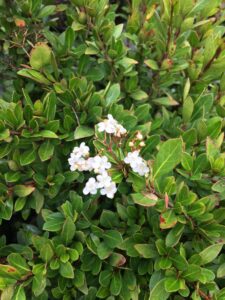S & J Nursery’s Guide to Growing Florida Native
Walters Viburnum
( Viburnum Obovatum )
Shrubs in the Northeast Florida Landscape
Walters Viburnum Origins:
-Viburnum Obovatum is a Florida Native plant. In nature they are found growing in most and wet swampy locations.
Walters Viburnum Preferred Exposure:
– Viburnum will tolerate full sun to partial sun situations in the North Florida | Jacksonville | St. Augustine areas gardens and landscapes.
Walters Viburnum Foliage:
-Small evergreen foliage makes this hardy shrub an excellent choice to add some foliage texture to the landscape. Small leaves area deep dark glossy green color.
Walters Viburnum Soil Preference / Salt tolerance:
– Viburnurn Walters Viburnum will tolerate well drained to wet soils and is not particular about the makeup or content of that soil. It tolerates clay, sand, loam acidic or alkaline conditions equally well.
– Recommended for use in poorly drained areas that will stay wet during our heavy rain season.
– Walters Viburnum Obavatum has a low salt tolerance and should be avoided on coastal properties.
Walters Viburnum Size Variance:
-Walters Viburnum can reach sizes of 8-20+ feet high | 6-10+ feet wide
Walters Viburnum Growth Habit:
– Viburnum obavatum is an upright rounded shrub or small tree taller than it is wide.
Walters Viburnum Growth Rate:
-Walters Viburnum shrubs are fast growing .
Walters Viburnum Blooms:
– Plants bloom heavily on the plant in spring and are followed by red berries that mature a darker black color.
Walters Viburnum Water Requirements:
– Walters Viburnum may require supplemental landscape irrigation during hot dry summers or prolonged periods of low local rainfall. Especially when planted in very well draining sandy soils.
Best Uses For Walters Viburnum:
– Walters Viburnum is a great choice for a tall growing shrub or small tree for privacy screens, hedge rows, topiary forms and espalier’s landscape specimens when allowed to grow into small tree.
– Low maintenance landscape plant perfect for moist soils where other plants would suffer from excess water.
Care of S & J Nursery’s North Florida | Jacksonville | St. Augustine Area Shrubs:
– Shrubs can be planted in the North Florida | Jacksonville | St. Augustine area at any time during the year. In normal and well draining soils dig the hole as deep as the root ball and two to three times as wide. Plant the top of the root ball level or slightly higher than the surrounding soils. When
planting in poorly drained soils make sure to plant your shrubs a minimum of 3 inches ABOVE the surrounding soil level.
– Water every day during the establishment period. For most 3 gallon size shrubs in the North Florida landscape in average soil, that is neither heavy clay that holds water or really sandy that will take 2-3 weeks of daily watering to ensure that your newly planted shrub will begin to put out new roots and grow into its new home happily. After the first few weeks begin tapering back your watering to every other day then every third day and so on until your newly planted items are flourishing without your assistance.
– If planting larger shrubs you may need to extend the initial care a bit longer to protect your investment and get your shrubs off to the best start possible.
– IMPORTANT: If planting shrubs in heavy clay soils that hold allot of water after a rain or irrigating, remember to check the soil for moisture by sticking your fingers into the soil near the root ball of the newly planted shrub down to 2-3 inches. If it remains wet from the previous watering wait for the top 2-3 inches to dry out before watering again.
– IMPORTANT: When planting shrubs into poor sandy soils be sure to amend the planting hole by mixing compost or cow manure etc. with the native soil that will go back in the hole around the new plants root ball when installing your shrub material, this will not only give your new shrubs good soil to grow its new roots into but help it hold water.
– When planting shrubs from containers be sure to loosen the roots as much as possible pulling loose roots away from the root ball before installing your new plants, if the roots are to tight to easily loosen with your hands use a knife to cut a few slits into the root ball being careful to go all the way from the top to the bottom and making the cut at least an inch deep. This will ensure that your plant will immediately begin to form new roots into its new surrounding soil.
– Mulch newly planted shrubs whenever possible.
– Fertilize each spring with a mixture of Milorganite and a slow release poly coated plant food such as Osmocote or Stay Green general purpose plant food, sprinkling the fertilizer around the mulch circle underneath the foliage of the tree
– Prune as needed to shape each spring and or summer.

